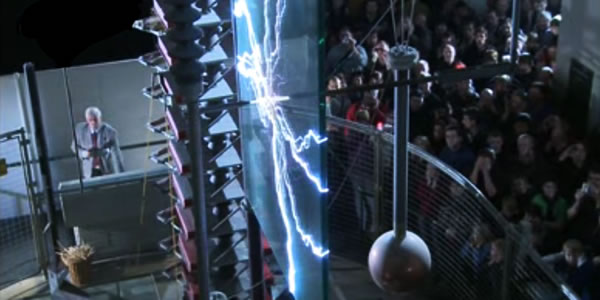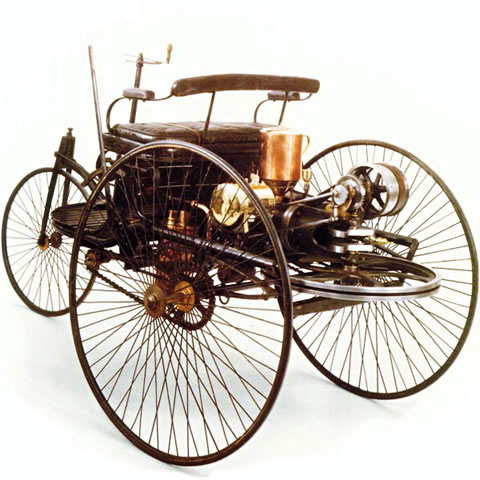Deutsches Museum ★

The High Voltage Show at the Deutsches Museum. (Photo courtesy of Deutsches Museum)
The awesome German Museum of Science & Technology in Munich

The world's first gasoline-powered vehicle, an 1886 Benz tricycle.The "German Museum" of Munich is a fantastic see-and-touch science museum.
The placards are in German and English, and the rooms cover in incredible depth such diverse subjects as industrial machinery, the digging of tunnels, astronautics, computers and microelectronics, textiles, mining, and electricity.
Definitely don't miss the noon High Voltage demonstrations at the Faraday Cage that actually produce lightning—they even stick some poor employee in a tiny Faraday sphere and run 20,000 volts through it, just to entertain the kiddies. (in German only, but indoor lightning is impressive in any language).
Kids will have a blast.
There's a hangar filled with historic aircraft and a collection of venerable cars, including the very first automobile—a motorized tricycle patented by Carl Benz in 29 January 1886 and the first vehicle to use a gasoline-powered engine.
Other firsts enshrined here include the diesel engine (1897), electric dynamo (1866), and the lab bench at which Hahn and Strassmann first split the atom (1938).
Tips & Links
Museuminsel 1 (on an island in the Isar river)
Tel. +49-(0)89/21-791
www.deutsches-museum.de
OPEN
Daily 9am–5pm
ADMISSION
€8.50
TRANSPORT
U-Bahn: Fraunhoferstrasse (U1, U2)
S-Bahn: Isartorplatz
Tram: 16, 18
Bus: 132
Planning your time: The Deutsches Museum will take at least an hour, probably more like two or three if you read a lot of the plaques.
Tourist info: Muenchen.de, Bavaria.by, Germany.travel
Tours & activities: Viator.com, City-Discovery.com, Intrepidtravel.com, Gadventures.com
LODGING
- Apartments & villas:
- Vrbo.com
- Booking.com
- Venere.com
- Rentalo.com
- Homeaway.com
- Belvilla.com
- Interhomeusa.com
- Airbnb.com
- Villasintl.com
- Craigslist.org
TRANSPORT
- Airfares:
- Momondo.com
- AutoEurope.com
- Vayama.com
- CheapOair.com
- Cheapflights.com
- DoHop.com
- CheapTickets.com
- Priceline.com
- Trains:
- Bahn.de
- Raileurope.com
- Seat61.com
- Car/RV rentals:
- Autoeurope.com
- Momondo.com
- RentalCars.com
- CheapOair.com
- AutoSlash.com
Bike rentals & tours: Viator.com, Mikesbiketours.com
- Sightseeing
- Food & beer
- Day-trips
- Excursions
- Munich City Hop-on Hop-off Tour
- Munich Bike Tour
- Munich Segway Tour
- Private Tour: Munich Segway Tour Including Chinese Tower Beer Garden
- Private Tour: Munich Electric Bike Tour
- Munich Art Tour: Neue Pinakothek
- Hitler and the Third Reich Walking Tour
- Private Tour: Munich Sightseeing Including Andechs Monastery
- Munich City Tour including FC Bayern Soccer Grounds Visit
- Munich Ghost Walking Tour
- Munich Super Saver: Paulaner Brewery and Beer Tour plus Express Hop-On Hop-Off Tour
- Munich Oktoberfest Tickets and Tour
- Munich Christmas Markets Tour
- Munich City and Bavaria Film Studio Tour
- Hard Rock Cafe Munich
- Munich by Night and Dinner at Hofbrauhaus
- Munich Oktoberfest Tickets and Tour
- Bavarian Beer and Food Evening Tour in Munich
- Munich Bavarian Food Walking Tour
- Behind-the-Scenes Paulaner Brewery and Beer Tour in Munich
- Munich Super Saver: Paulaner Brewery and Beer Tour plus Express Hop-On Hop-Off Tour
- Munich Segway Tour During Oktoberfest
- Private Tour: Royal Castles of Neuschwanstein and Hohenschwangau from Munich
- Private Tour: Dachau Concentration Camp Tour from Munich
- Royal Castles of Neuschwanstein and Linderhof Day Tour from Munich
- Salzburg Small Group Day Tour from Munich
- Salzburg and Lake District Day Tour from Munich
- Neuschwanstein Castle Small Group Day Tour from Munich
- Dachau Concentration Camp Memorial Small Group Tour from Munich
- Dachau Concentration Camp Memorial Afternoon Tour from Munich
- Romantic Road, Rothenburg and Harburg Day Tour from Munich
- Berchtesgaden and Eagle's Nest Day Tour from Munich
- Nuremberg Day Trip from Munich
- Private Tour: Nuremberg Day Trip with Train Transport from Munich
- Nuremberg Third Reich and Roman Empire Historical Day Trip
- Herrenchiemsee Palace Rail Trip from Munich
- Royal Castle of Herrenchiemsee and Fraueninsel Day Tour from Munich
- Ettal Monastery and Zugspitze Day Tour from Munich
- Swarovski Crystal Worlds and Innsbruck Day Trip from Munich
- Royal Castle of Linderhof and Oberammergau Day Tour from Munich
- 3-Day Munich to Frankfurt Tour - Romantic Road, Rothenburg, Hohenschwangau, Neuschwanstein
- 4-Day Tour from Munich to Frankfurt: Romantic Road, Rothenburg, Augsburg, Neuschwanstein Castle
- 2-Day Munich Super Saver: Salzburg and Lake District Day Trip plus Romantic Road and Rothenburg Day Trip
- 2-Day Royal Castles Tour - Linderhof, Hohenschwangau, Neuschwanstein
- 2-Day Munich to Frankfurt - Romantic Road, Rothenburg
- 5-Day Tour from Munich to Frankfurt: Rothenburg, Augsburg, Zugspitze
- 4-Day Munich to Frankfurt - Romantic Road, Linderhof, Hohenschwangau, Neuschwanstein
- 3-Day Munich to Frankfurt - Romantic Road, Heidelberg, Rothenburg

Related Articles |
|
This article was by Reid Bramblett and last updated in September 2013.
All information was accurate at the time.
Copyright © 1998–2013 by Reid Bramblett. Author: Reid Bramblett.
